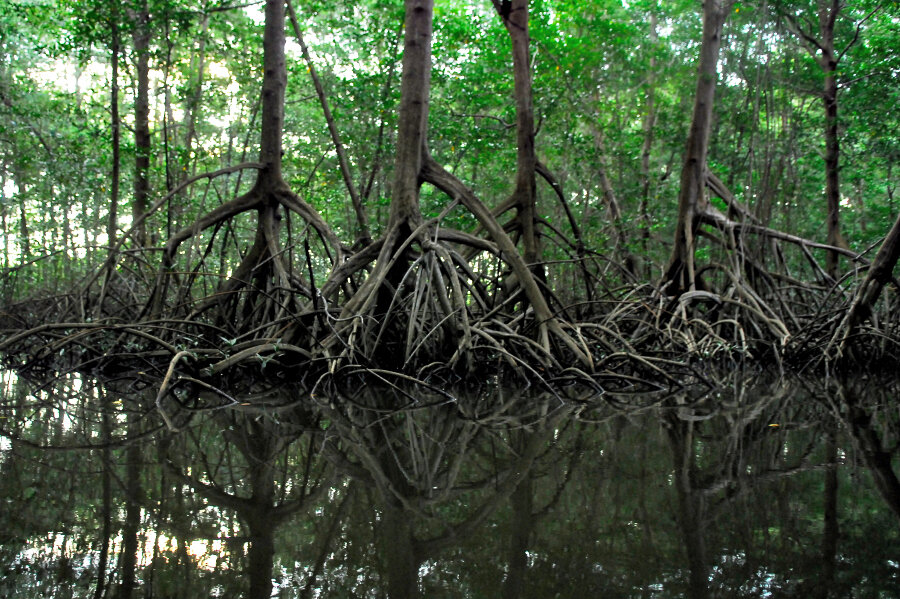Women lead effort to protect Sri Lanka's mangroves
Loading...
| COLOMBO, Sri Lanka
Sri Lanka's new mangrove protection scheme, the world's first country-wide initiative, is relying on women like Michel Priyadarshani, head of a fisherwomen's group in eastern Ambantotam village.
Priyadarshani and her colleagues did not understand the importance of mangroves for the ecosystem, including the fish population, until they benefited from a program offering micro credit in return for looking after the coastal forests.
"Now we know - and from us, our husbands and our community also have become aware," Priyadarshani said.
Since 1997, Sudeesa, a national organization that works to protect coastal ecosystems, has given women living near mangrove forests financial assistance - mainly loans of $50 to $2,000 each - incentivizing them to care for the delicate trees.
Now the program is about to go island-wide. Sudeesa, together with the Sri Lankan government and U.S.-based environmental conservation group Seacology, recently launched a five-year, $3.4 million mangrove preservation initiative.
Sri Lanka is the first nation to promise to protect all its mangroves, experts said.
Mangrove trees grow in saltwater, forming a vital part of the natural cycle in coastal lagoons. Fish and other marine creatures like prawns use the deep roots as breeding areas.
The forests protect coastal communities from abrupt tidal shifts and storms, while slowing shore erosion.
"People who live near mangroves tell us the trees act as a buffer against the wind and heavy rains, breaking their intensity just before they make landfall," said Douglas Thisera, director for coastal conservation at Sudeesa, formerly known as the Small Fishers Federation of Lanka.
Mangrove swamps also store carbon, sequestering it in the top few meters of underwater soil and keeping it there longer than other trees.
K D Wijitha, who runs a group bringing together women from 23 villages in the northwestern Kalapitiya area, said they had learned to look after the mangrove forests.
"We make sure that they are safe," she said.
Thanks to the Sudeesa program, Kristina Jospin from Samadigama village in northwestern Puttalam District received training and financial aid to operate a small bakery, which allows her to support her sick husband and four children.
Sudeesa credit officer Suvinetha de Silva said the program usually targets the poorest women, who are unable to seek credit from banks.
The new national scheme aims to set up 1,500 community groups around Sri Lanka's 48 lagoons, which will offer alternative job training and micro-loans to 15,000 people. The groups will be responsible for the upkeep of designated mangrove forests.
Pilot projects showed a high success rate, said Duane Silverstein, executive director of Seacology. Almost 2,000 loans were made to women, with a repayment rate of over 96 percent.
"With very small loans of around $100, several of the women were so successful that they already employed additional women," he said.
Half of loan recipients under the new program will be widows, while the rest will be male and female school dropouts.
Seacology and Sudeesa officials said each community group will be responsible for around 21 acres (8.5 hectares) of mangrove forest. The government has agreed to provide rangers to patrol the forests.
The program also plans to replant 9,600 acres (3,885 hectares) of mangroves.
The new government of President Maithripala Sirisena has brought the island's 21,782 acres (8,815 hectares) of mangroves under the Forest Ordinance Act, making it illegal for anyone to exploit them for commercial purposes.
"It is an extremely vital decision because now all mangroves around the island can be protected with the active participation of the Forestry Department," said Sudeesa chairman Anuradha Wickramasinghe.
Some three decades ago, Sri Lanka had at least 40,000 hectares (98,842 acres) of mangroves, Thisera said. But the bulk has been destroyed due to commercial exploitation and firewood use.
"The biggest threats to mangroves in Sri Lanka include prawn farms, which have been greatly curtailed in recent years, collateral damage from the civil war, and impoverished people cutting down mangroves to use or sell as charcoal," Seacology's Silverstein said.
The worst damage occurred in the northwest of the island nation, where commercial prawn farms took off in the 1990s. But most of these farms have been abandoned in the last few years due to the spread of disease.
The new mangrove protection scheme plans to introduce other trees that can provide an alternative fuel source, such as coconut husks.
Silverstein said the government's enthusiasm for protecting the mangrove forests could push other countries in the region to follow suit.
Defense Secretary B.M.U.D. Basnayake told Silverstein the national armed forces could help with replanting efforts.
Sudeesa's Wickramasinghe said the program's success would depend on how far local communities buy into it.
"We have to make them understand the mangroves are a boost to their lives and their incomes," he added.
• Reporting by Amantha Perera; editing by Megan Rowling.
• This article originally appeared at Thomson Reuters Foundation , a source of news, information, and connections for action. It provides programs that trigger change, empower people, and offer concrete solutions.







